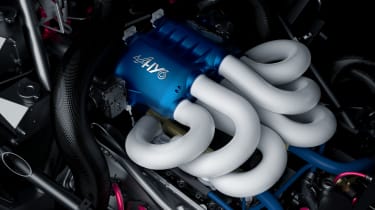Alpine Alpenglow Hy6 is a 205mph hydrogen-powered prototype supercar
The updated Alpenglow Hy6 gets an all-new 3.5-litre V6 with 740bhp, powered by hydrogen, more than doubling the power output of the original concept.
Alpine has revealed an updated version of the Alpenglow concept with a 740bhp 3.5-litre V6, good for 9,000rpm, that’s powered by hydrogen.
This comes hot on the heels of our earlier report based on a conversation with Alpine CEO Philippe Kriefe, where he explained how for Alpine 'having a supercar is very important’ for the brand. All signs are pointing to something exotic and sonorous just around the corner, to join the likes of the Alpine A390 and Alpine A290 in its upcoming roster.
For now, though, we have the Alpenglow Hy6 prototype, which more than doubles the power output of the Alpenglow Hy4 seen previously. The all new internal combustion engine uses an alloy block with 100-degree V angle, 95mm and 82.3mm bore and stroke, four overhead cams, twin turbochargers and dry sump lubrication. Full figures are 740bhp at 7,600rpm, ahead of a 9,000rpm redline, and 567lb-ft from 5,000rpm. The Alpenglow Hy6’s top speed is claimed to be in excess of 205mph.
It all sounds very conventional, only the direct injectors feed the engine hydrogen, while indirect injectors feed it water. They’re fed in turn by three hydrogen tanks that store 2.1kg each of gaseous hydrogen at 700 bar of pressure.
The car’s basis is an LMP3 carbon chassis, with the tanks housed in the sidepods and behind the passenger cell. The tanks are Regulation 134 certified, which is the European standard for hydrogen vehicle safety. Power arrives at the rear wheels only via a six-speed sequential transmission.
Sound and driving sensations were key in Alpine’s decision to pursue a combustion solution with hydrogen, rather than hydrogen fuel cells and electric motors. We're told that ‘Formula 1 engine development methodologies’ have been used, which would make sense given that the powertrain was developed at the marque’s Viry-Catillon facility. Even though Renault and Alpine are shortly to shut up shop on factory F1 engine development, the considerable resources at their disposal are being redirected to research projects like this, as well as into the World Endurance Championship Hypercar.
Bruno Famin, VP of Alpine Motorsports, said: ‘With the development of this brand new Hy6 V6 engine, we are demonstrating our commitment to hydrogen research, which could herald motorsport applications with high-performance levels.’
‘A solution for continuing to cultivate the passion for motor racing using a very noble V6 with remarkable specific power and a sound to thrill drivers and spectators with its maximum revs at 9,000 rpm. The Alpenglow Hy6 concept is the perfect example of what is possible to achieve the essential step of reducing carbon emissions in motorsport.’
In terms of design, such a rise in performance potential means the Alpenglow has been massaged, both to carry and cool the larger V6, and to harness its potency aerodynamically. At the rear there’s a clear view of the new engine, with the bridge that connected the rear wings now ditched. The larger, more aggressive wing is transparent, to allow for the best view possible of the engine in the back. The inconel exhausts exit through the rear lights, with the water vapour they emit ‘frosting’ the spoiler. There’s a much larger shark fin too, for stability at increased speeds.
For now, it appears this isn’t a vanity project – no manufacturers can afford such things at the moment. Rather, a genuine investigative project looking at a sustainable but more emotive future for both sports and supercar propulsion – but also for racing cars. Alpine is said to be ‘paying close attention to changes in competition regulations,’ specifically the plan to allow hydrogen cars to race at Le Mans from 2028.











